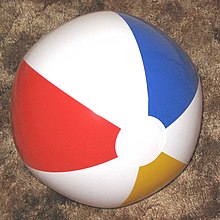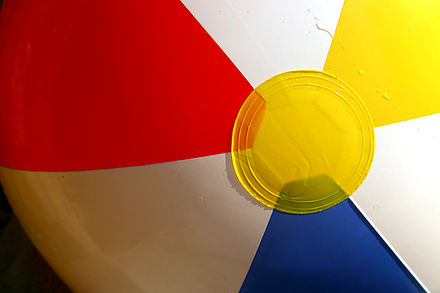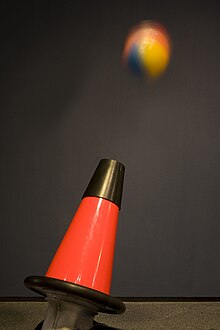Water polo (toy)
A water ball is a light, large, inflatable ball that is primarily used for beach and water games. The low weight ensures slow sailing through the air in throwing games. The size usually requires the use of both hands, which makes beach balls ideal toys for children. However, the combination of size and low weight also has the disadvantage that beach balls are blown away by even weak winds. Another disadvantage is the relatively low load capacity.
history

The invention of the water ball is sometimes attributed to a Californian named Jonathan DeLonge and is dated to 1938. However, pictures are already known from the 1920s that show beach beauties with water polo.
The early beach balls were made of rubberized cotton fabric, whereas nowadays only plastic film (see below) is used. The resulting cheaper production allowed mass distribution, also as an advertising medium, from the 1960s.
Material and workmanship
The single-layer ball skin is nowadays almost exclusively with softening substances -provided PVC manufactured foil of 150 to 400 microns thickness. This film is usually high-frequency welded from several strips . Before the last weld, the seams of the welds are turned inwards; the last weld seam then necessarily points outwards. Finally, two round pieces of film are placed as end pieces. A retractable stopper valve is incorporated into one of these ends, allowing inflation with a hand pump or the mouth.
A common design are colored stripes alternating with white stripes (often three colored and three white). Beach balls for advertising purposes are provided with appropriate imprints. A globe imprint can also be found from time to time.
In addition to the typical sizes of 30 to 60 cm in diameter, beach balls are produced in a wide range of mini and large sizes; there are also giant beach balls with a diameter of several meters. The mass essentially depends on the size, since the foil area is proportional to the square of the diameter. In addition, thicker foils are often used for larger balls than for smaller ones. Typical values are therefore distributed over a wide range between 50 and 500 g.
Areas of application
game
Beach balls are suitable for regular throwing games and for romping around, especially for children. Giant beach balls are also occasionally used at rock concerts and similar mass events, where they are tossed around by the audience. A megaball is a large transparent ball that a person can step into and use it to move across water.
Sports
Regular team ball games such as the water polo or volleyball sport of the same name are also possible with water balls; the fact that the wind can easily influence the game, which can lead to unexpected game turns, is a very desirable fun factor. A disadvantage that limits the use for games such as soccer , in which the ball is exposed to high impact and pressure loads, is the low mechanical strength.
The use of a water ball as a fitness device is in principle possible, but if the ball is repeatedly stressed with the body weight, the weld seams will tear. Exercise balls are better suited for this.
Infant promotion
Many books and the Prague Parent-Child Program (PEKiP) for the early intervention of infants recommend, among other things, exercises with a water ball. Popular suggestions are to hold a beach ball on a string over the baby to encourage it to move (slap, kick), or to place the baby on a beach ball and gently rock it back and forth on it (without letting go of it) . This is intended to promote body awareness and coordination.
photography
Because of their bright colors , beach balls are an often used accessory on photo subjects, especially for themed pictures about sun, beach and vacation. In professional fashion photography, they are often brought into the picture when introducing bathing suits or bikinis .
Sex toys
As sex toys in the narrower sense, beach balls (possibly not fully inflated) can be used as a springy pad during sexual intercourse. However, the load limit of the weld seams is also reached here.
Sexual connotations that even lead to the fetishization of beach balls provide the frequent depiction with lightly clad beauties, the haptic properties and the similarity of material (PVC film) with "lacquer" - lingerie . Beach balls are therefore also used for masturbation .
Demonstration of the Bernoulli law
A beach ball is ideal in connection with a blower to demonstrate Bernoulli's law of flow . According to this, the pressure within an air flow is lower than in the still ambient air: If you let a ball of water be lifted by an upward air flow, it will remain floating in it, even if you turn the air flow a little to the side. The higher pressure outside the flow zone holds the ball in place.
Beach balls in the media
A major film role is played by a beach ball in the 1974 science fiction parody Dark Star directed by John Carpenter . He plays an unruly alien there.
One of the factual stories of the WDR- produced program mit der Maus from 2004 is dedicated to water polo.
Beach polo symbols
Beach balls are water ball-like signatures that are used in seismology to map earthquake sources. The name is derived from the English term beach ball for water polo.
In the Unicode standard so far (version 6.0) there are some types of balls as symbols, but there is still no water polo symbol with which, for example, playing and swimming opportunities for children could be drawn on maps. The radioactivity symbol (☢), which is stored under the hexadecimal code number 2622, is somewhat similar to a typical beach ball .
Individual evidence
- ↑ http://www.gettyimages.de/detail/HQ2677-001/Hulton-Archive
- ↑ To top form with the beach ball: Shape 9/2008, pp. 54–61
- ↑ Karin Schutt (2007): Baby Fun: Pekip, Massage, Games, Music & Co. Trias, Stuttgart, 124 pages. ISBN 978-3830433736
- ^ Anne Pulkkinen (2008): PEKiP: Supporting babies in a playful way. Gräfe and Unzer, Munich, 128 pages. ISBN 978-3833811760
- ↑ Cornelia Lohmann (2010): Babies in Motion. Meyer & Meyer, Aachen, 144 pages. ISBN 978-3898995474
- ↑ http://www.sarilocker.com/advice/qa.php?id=1158
- ^ The Editors of Cosmopolitan: Cosmo's Aqua Kama Sutra (2006): 25 Sex Positions for the Tub, Shower, Pool, and More. Hearst, 64 pages. ISBN 978-1588165718 (in English)
- ↑ http://www.cosmopolitan.de/liebe-sex/sex/a-22005-3/das-aquasutra.html
- ↑ Archived copy ( Memento of the original from August 22, 2013 in the Internet Archive ) Info: The archive link was inserted automatically and has not yet been checked. Please check the original and archive link according to the instructions and then remove this notice.
- ↑ http://www.sexspielzeug-basteln.com/strandball-kitzler.html
- ↑ http://expvorl.physik.uni-muenchen.de/versuche_mechanik/stroemende_medien/bernoulli_wasserball/index.html
- ↑ http://www.imdb.com/title/tt0069945/
- ↑ http://www.wdrmaus.de/sachgeschichten/abisz/index.php5?page=1&abisz=w
- ↑ http://www.unicode.org/charts/PDF/U2600.pdf


